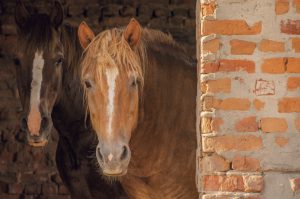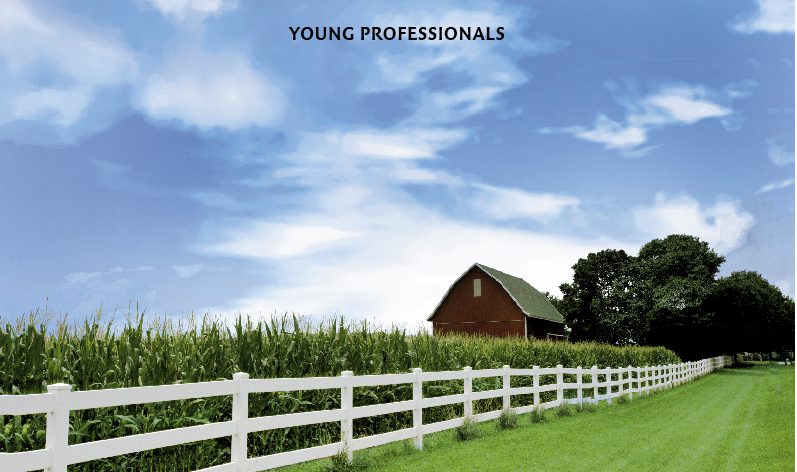OLD MACDONALD HAS A FARM (E-I-E-I-O)—OR DOES HE?
A look at farm and ranch best practices and exposures
By Christopher W. Cook
It was easy to come up with a title for an article on farm and ranch insurance, considering that “Old MacDonald Had a Farm” is a go-to song for comforting my (while I write this) 18-month-old son during car rides. After three or four rounds of repeating various farm animals, all of a sudden Old MacDonald has now inherited a zoo. And the song continues. E-I-E-I-O!
We recently ran an article titled “Writing Farm Insurance Requires a Different Approach.” While that article focused on policies to look at when insuring a farm, for this Young Professionals feature, we’re going to discuss exposures present and best practices when starting a relationship with farm and ranch clients, as discussed in a 2021 PRMA Summit session titled “Saddle Up and Strategize Symposium—How to Protect the Rural Lifestyle.”
“No two properties are the same. Placing the right coverage really takes an in-depth knowledge of all the inner workings of each farm.”
—Susan Muston
Sales Program Director
AIG Private Client Group
In her session introduction, Susan Muston, sales program director at AIG Private Client Group, who served as the panel’s moderator, presented a scenario of a client purchasing a rural home on 1,500 acres of land. A property that large must require a farm or ranch policy, right? Well, it depends.
What are some common misconceptions regarding farm and ranch? Panelist Lesa Blaser, senior vice president at AmWINS Access, commented that just because a property is on a lot of acreage doesn’t necessarily classify it as a farm or ranch. Neither does giving the property a name that includes the word farm or ranch. “You really need to know what they are doing on the land that makes it a farm or ranch,” she said. “Years ago, the only place you could get coverage at a decent rate was farm and ranch if the property was on acreage. Well, things have changed. Now, you have to look at the exposures.”
So, what qualifies as a farm or ranch; how is it defined?
Blaser described it as a location with a residence, whether primary or secondary, with some type of farming exposure on the land, whether it be raising hay or having cattle. In addition, said panelist Brenda Weaver, account executive and broker at Aon Private Risk Management, “Most farm and ranch carriers are requiring that there be some type of revenue. So, for our clients that are doing this as a hobby, sometimes it can be a little more difficult to place. Sometimes we fall more under the rural lifestyle, and we may have to go back to a homeowners policy.”
As Weaver defined, different types of farms include:
- Acreage with maybe small operations, but not as a source of primary income
- Gentleman’s. Similar to a hobby farm, but part of a larger estate
- Primary income earned (e.g., growing crops or with livestock)
- Truly for profit; may or may not include a residence
- A farm that involves horses, whether through boarding, training or riding
- A farm that is set up to encourage tourism (e.g., tours, hay-rides, you pick your own fruit, etc.)
The easiest way to figure out which type of farm describes your client’s property is to ask questions, and lots of them.
“Years ago, the only place you could get coverage at a decent rate was farm and ranch if the property was on acreage. Well, things have changed. Now, you have to look at the exposures.”
—Lesa Blaser
Senior Vice President
AmWINS Access
In Texas, there’s a “nice Ag exemption that everyone wants to get,” said Ashleigh Trent, co-founder of Dallas, Texas-based Tower Street Insurance. “They’re usually happy to tell me what they’re doing [on the property] to meet those guidelines.
“We also know that everything always seems to change with our clients; they always find some way of making money from anything. So, we make sure that we’re asking the right type of questions about the extent of their farming and ranching exposures to make sure that we get the adequate protection for what they really are doing on that property.”
Some “must ask” (among the many to ask) questions, according to Trent, include:
- Who owns the property?
- What’s the address?
- Is all the land in one location?
- What buildings are on the property?
- What types of operations are being conducted?
- Do you have employees and what do they do?
“You really have to become a private investigator,” said Weaver. “I start with an open-ended question and get the client talking, and then I’m going to listen for clues of things that they might not think to disclose. You will be surprised at how many of our clients have an annual special event. Any type of public footwork on your property definitely leads to a larger liability exposure.
“Nine times out of 10, I’m finding recently that my clients will have some type of hunting exposure,” she continued. “So I’m asking questions about that. Is the hunting just for you and your family and friends? Are you bringing business associates or clients onto the property? Are you generating revenue from that hunt? Are you having your guests that do hunting on your property sign waivers? There are so many different questions that impact how you’re going to ensure risks.”
“[T]he personal umbrella policy doesn’t automatically cover farm and ranch, so make sure that you have a separate farm and ranch umbrella policy to cover added layers of exposure and risk.”
—Ashleigh Trent
Co-founder
Tower Street Insurance
As for information about the land itself, “We’re very fortunate that most of the counties across the country are very open with their public records; you can Google search most any county’s property appraiser website or tax assessor’s office to get details on the properties,” Weaver said.
What if an exact address is difficult to identify?
“Ask them how they’re going to get the fire department there in case of an emergency,” Weaver said. “I can guarantee they have some good way to identify the property.”
From an underwriting perspective, Blaser stressed the importance of having as much information as possible, and agents should submit all completed forms at the same time. “I honestly recommend, if possible, go to the farm yourself and see what’s going on, because sometimes there are things going on at the farm or ranch that the owner doesn’t know about,” she said. “For [the underwriter] to give you a proper quote, [they] need to know the exposures.”
Exposures
Identifying all exposures on a property is of the utmost importance. Blaser, herself, witnessed a unique risk at one farm client she had visited, a risk un-aware of by the owners.
“They had their own water truck,” she said, “and they had trained their employees on how to work that equip-ment and help mitigate a fire while the fire department was enroute. Well, that’s wonderful, but then you’re out there talking and learn that ‘[they] do that for everyone that’s nearby.’ You can imagine the liability exposure; it’s not covered. You’re taking [the equip-ment] off premises, and you’re helping put out fires.”
The other panelists also had their fair share of unique risks that a farm and ranch policy wouldn’t cover. A horse ranch in Kentucky that Weaver visited also had an on-site venue for weddings and corporate events, and even used a secondary residence on the property for Airbnb rentals. Trent had a client who jointly owned a property with multiple entities. Different segments of the property were used for different purposes. “It got complicated quickly,” she said. “The other thing to remember is that the personal umbrella policy doesn’t automatically cover farm and ranch, so make sure that you have a separate farm and ranch umbrella policy to cover added layers of exposure and risk.
“You really have to become a private investigator. I start with an open-ended question and get the client talking, and then I’m going to listen for clues of things that they might not think to disclose.”
—Brenda Weaver
Account Executive and Broker
Aon Private Risk Management

HAY! WHAT ABOUT HORSES?
Fire and theft are the largest threats to horse safety. In a 2021 article, Cliverton, a U.K.-based livery yard insurance supplier (www.cliverton.co.uk), shared some best practices to keeping equine clients’ animals safe.
- No smoking. Barns are full of flammable material, so make sure a non-smoking policy is in place in your barn areas and that cobwebs and dung piles are frequently removed.
- Fire extinguisher. Have one, or several, onsite and stored properly. Easy enough.
- Varied timetables. To thwart off thieves, visit the stable at different times and mix up your schedule; make the yard constantly look busy.
- Security lights. Use sensor-operated lights on the grounds to make intruders more visible.
- Burglar alarms. An acoustic alarm can signal when someone has entered the stable. This can also help alert others in the area. Become acquainted with neighbors so you can provide additional eyes on one another’s facilities.
- Warning signs. Post signs around the property like “keep out” or directly mention that there is as security system in place.
- Keep items out of sight. Tools, ladders and other possessions should be put away when not in use. Out of sight, out of mind.
- Horse identification. Evidence of identification tags may make thieves think twice, as they might dismiss taking a microchipped horse due to the ability to track it. Like dogs, it is wise to have your horses chipped in case they are lost or stolen.
“It’s really important to avoid errors and omissions (E&O) and understand that there is a huge difference between personal lines and farm and ranch,” she continued. “[In personal lines], if it’s not excluded in the policies, we expect there to be coverage. Farm and ranch is very different; it’s what you see is what you get. If it’s not detailed on the declarations page or in the endorsements, you better assume that it’s not covered.”
When insureds have a plethora of land, they may constantly be adding structures or trying new ventures, so “stay in touch with your clients,” Blaser said. “Don’t wait for that annual once-a-year review. Literally check to see what changes are going on or what they plan on doing in the future.”
Blaser shared that one client added a shooting range on the property, which isn’t out of the usual in the country. But they would later invite the local sheriff’s department to come onsite to use it for training.
“Those things aren’t covered unless you insure them properly, and the client didn’t think anything about it,” she said. “You need to make sure your client understands that when they’re going to change something they need to let you know, because they’ll have a gentle-man’s agreement and let one of their neighbors use their property to maybe go hunting with some friends or riding ATVs.”
And with the elevated level of activity in recent years, don’t forget about fire.
“Fire risk is huge right now,” Blaser said. “Have the fire department come out. Be very proactive. If you see that you’ve got a building on your property that is falling, have it torn down.”
Blaser also warned about the exposures of having fuel on the property. “There are other issues besides just combustion,” she said, “like if it leaks to the ground or if it gets into the water storage. That’s also the same for fertilizers or pesticides.
“One thing [the underwriter] is always going to look at is loss history. Even if it’s a new purchase, [they’re] still going to look at loss history for that location and the individual. We’re seeing a lot of issues with new purchases, new venture; people are buying farmland left and right. A lot of farm and ranch markets aren’t comfortable with someone all of a sudden coming from a city and having all this equipment and animals. When you have something like that, provide information on the account. What experience does the new owner have? Is he keeping the current management team and employees?”
To conclude, when it comes to farm and ranch, “no two properties are the same,” Muston said. “Placing the right coverage really takes an in-depth knowledge of all the inner workings of each farm.”
For more information:
AIG Private Client Group
www.aig.com/pcg
AmWINS Access
www.amwins.com
Aon Private Risk Management
www.aon.com/risk-services/private-risk-management
Private Risk Management Association
www.privateriskmanagement.org
Tower Street Insurance
www.towerstreetinsurance.com






